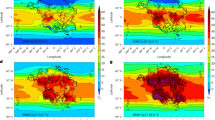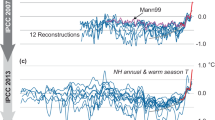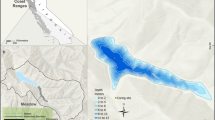Abstract
Glacial climate is marked by abrupt, millennial-scale climate changes known as Dansgaard–Oeschger cycles. The most pronounced stadial coolings, Heinrich events, are associated with massive iceberg discharges to the North Atlantic. These events have been linked to variations in the strength of the Atlantic meridional overturning circulation. However, the factors that lead to abrupt transitions between strong and weak circulation regimes remain unclear. Here we show that, in a fully coupled atmosphere–ocean model, gradual changes in atmospheric CO2 concentrations can trigger abrupt climate changes, associated with a regime of bi-stability of the Atlantic meridional overturning circulation under intermediate glacial conditions. We find that changes in atmospheric CO2 concentrations alter the transport of atmospheric moisture across Central America, which modulates the freshwater budget of the North Atlantic and hence deep-water formation. In our simulations, a change in atmospheric CO2 levels of about 15 ppmv—comparable to variations during Dansgaard–Oeschger cycles containing Heinrich events—is sufficient to cause transitions between a weak stadial and a strong interstadial circulation mode. Because changes in the Atlantic meridional overturning circulation are thought to alter atmospheric CO2 levels, we infer that atmospheric CO2 may serve as a negative feedback to transitions between strong and weak circulation modes.
This is a preview of subscription content, access via your institution
Access options
Access Nature and 54 other Nature Portfolio journals
Get Nature+, our best-value online-access subscription
$29.99 / 30 days
cancel any time
Subscribe to this journal
Receive 12 print issues and online access
$259.00 per year
only $21.58 per issue
Buy this article
- Purchase on Springer Link
- Instant access to full article PDF
Prices may be subject to local taxes which are calculated during checkout




Similar content being viewed by others
References
Dansgaard, W. et al. Evidence for general instability of past climate from a 250-kyr ice-core record. Nature 364, 218–220 (1993).
Barker, S. et al. 800,000 years of abrupt climate variability. Science 334, 347–351 (2011).
Rahmstorf, S. Ocean circulation and climate during the past 120,000 years. Nature 419, 207–214 (2002).
Stommel, H. Thermohaline convection with two stable regimes of flow. Tellus 13, 224–230 (1961).
Ganopolski, A. & Rahmstorf, S. Rapid changes of glacial climate simulated in a coupled climate model. Nature 409, 153–158 (2001).
McManus, J. F., Oppo, D. W. & Cullen, J. L. A 0.5-million-year record of millennial-scale climate variability in the North Atlantic. Science 283, 971–975 (1999).
Wunsch, C. Abrupt climate change: an alternative view. Quat. Res. 65, 191–203 (2006).
Zhang, X., Lohmann, G., Knorr, G. & Purcell, C. Abrupt glacial climate shifts controlled by ice sheet changes. Nature 512, 290–294 (2014).
Zhang, X., Lohmann, G., Knorr, G. & Xu, X. Different ocean states and transient characteristics in Last Glacial Maximum simulations and implications for deglaciation. Clim. Past 9, 2319–2333 (2013).
Menviel, L., Timmermann, A., Friedrich, T. & England, M. H. Hindcasting the continuum of Dansgaard–Oeschger variability: mechanisms, patterns and timing. Clim. Past 10, 63–77 (2014).
Hemming, S. Heinrich events: massive Late Pleistocene detritus layers of the North Atlantic and their global climate imprint. Rev. Geophys. 42, RG1005 (2004).
Marcott, S. A. et al. Ice-shelf collapse from subsurface warming as a trigger for Heinrich events. Proc. Natl Acad. Sci. USA 108, 13415–13419 (2011).
Bassis, J. N., Petersen, S. V. & Mac Cathles, L. Heinrich events triggered by ocean forcing and modulated by isostatic adjustment. Nature 542, 332–334 (2017).
Bond, G. et al. A pervasive millennial-scale cycle in North Atlantic Holocene and glacial climates. Science 278, 1257–1266 (1997).
Barker, S. et al. Icebergs not the trigger for North Atlantic cold events. Nature 520, 333–336 (2015).
Jouzel, J. et al. Orbital and millennial Antarctic climate variability over the past 800,000 years. Science 317, 793–796 (2007).
Stocker, T. F. & Johnsen, S. J. A minimum thermodynamic model for the bipolar seesaw. Paleoceanography 18, 1–9 (2003).
Barker, S. & Knorr, G. A paleo-perspective on the AMOC as a tipping element. PAGES News 24, 14–15 (2016).
Barker, S. & Knorr, G. Antarctic climate signature in the Greenland ice core record. Proc. Natl Acad. Sci. USA 104, 17278–17282 (2007).
Bereiter, B. et al. Revision of the EPICA Dome C CO2 record from 800 to 600 kyr before present. Geophys. Res. Lett. 42, 1–8 (2015).
Kawamura, K. et al. State dependence of climatic instability over the past 720,000 years from Antarctic ice cores and climate modeling. Sci. Adv. 3, 1–14 (2017).
Knorr, G. & Lohmann, G. Rapid transitions in the Atlantic thermohaline circulation triggered by global warming and meltwater during the last deglaciation. Geochem. Geophys. Geosyst. 8, Q12006 (2007).
Banderas, R., Alvarez-Solas, J., Robinson, A. & Montoya, M. An interhemispheric mechanism for glacial abrupt climate change. Clim. Dynam. 44, 2897–2908 (2014).
Ahn, J. & Brook, E. J. Siple Dome ice reveals two modes of millennial CO2 change during the last ice age. Nat. Commun. 5, 3723 (2014).
Grant, K. M. et al. Rapid coupling between ice volume and polar temperature over the past 150,000 years. Nature 491, 744–747 (2012).
Marcott, S. A. et al. Centennial-scale changes in the global carbon cycle during the last deglaciation. Nature 514, 616–619 (2014).
Li, C., Battisti, D. S. & Bitz, C. M. Can North Atlantic Sea ice anomalies account for Dansgaard–Oeschger climate signals? J. Clim. 23, 5457–5475 (2010).
Peterson, L. C., Haug, G. H., Hughen, K. A. & Roehl, U. Rapid changes in the hydrologic cycle of the tropical Atlantic during the last glacial. Science 290, 1947–1951 (2000).
Voelker, A. H. L. Global distribution of centennial-scale records for Marine Isotope Stage (MIS) 3: a database. Quat. Sci. Rev. 21, 1185–1212 (2002).
Lohmann, G. Atmospheric and oceanic freshwater transport during weak Atlantic overturning circulation. Tellus 5, 438–449 (2003).
Rahmstorf, S. On the freshwater forcing and transport of the Atlantic thermohaline circulation. Clim. Dynam. 12, 799–811 (1996).
Knorr, G. & Lohmann, G. Southern Ocean origin for the resumption of Atlantic thermohaline circulation during deglaciation. Nature 424, 532–536 (2003).
Broecker, W. S., Bond, G., Klas, M., Bonani, G. & Wolfli, W. A salt oscillator in the glacial Atlantic? 1. The concept. Paleoceanography 5, 469–477 (1990).
Schmidt, M. W., Vautravers, M. J. & Spero, H. J. Rapid subtropical North Atlantic salinity oscillations across Dansgaard–Oeschger cycles. Nature 443, 561–564 (2006).
Zaucker, F. & Broecker, W. S. The influence of atmospheric moisture transport on the fresh water balance of the Atlantic drainage basin: general circulation model simulations and observations. J. Geophys. Res. 97, 2765–2773 (1992).
Collins, M. et al. in Climate Change 2013: The Physical Science Basis (eds Stocker, T. F. et al.) 1029–1136 (IPCC, Cambridge Univ. Press, 2013).
Ahn, J. & Brook, E. J. Atmospheric CO2 and climate on millennial time scales during the last glacial period. Science 83, 83–85 (2008).
Leduc, G. et al. Moisture transport across Central America as a positive feedback on abrupt climatic changes. Nature 445, 908–911 (2007).
Peltier, W. R. & Vettoretti, G. Dansgaard-Oeschger oscillations predicted in a comprehensive model of glacial climate: a ‘kicked’ salt oscillator in the Atlantic. Geophys. Res. Lett. 41, 7306–7313 (2014).
Schmittner, A. & Galbraith, E. D. Glacial greenhouse-gas fluctuations controlled by ocean circulation changes. Nature 456, 373–376 (2008).
Roeckner, E. et al. The Atmospheric General Circulation Model ECHAM5. Part 1: Model Description Report No. 349, 1–127 (Max-Planck-Institut fuer Meteorologie, 2003).
Brovkin, V., Raddatz, T., Reick, C. H., Claussen, M. & Gayler, V. Global biogeophysical interactions between forest and climate. Geophys. Res. Lett. 36, 1–5 (2009).
Marsland, S. J., Haak, H., Jungclaus, J. H., Latif, M. & Röske, F. The Max-Planck-Institute global ocean/sea ice model with orthogonal curvilinear coordinates. Ocean Model. 5, 91–127 (2003).
Hibler, W. III A dynamic thermodynamic sea ice model. J. Phys. Oceanogr. 9, 815–846 (1979).
Jungclaus, J. H. et al. Climate and carbon-cycle variability over the last millennium. Clim. Past 6, 723–737 (2010).
Knorr, G., Butzin, M., Micheels, A. & Lohmann, G. A warm Miocene climate at low atmospheric CO2 levels. Geophys. Res. Lett. 38, 1–5 (2011).
Knorr, G. & Lohmann, G. Climate warming during Antarctic ice sheet expansion at the Middle Miocene transition. Nat. Geosci. 7, 2–7 (2014).
Stepanek, C. & Lohmann, G. Modelling mid-Pliocene climate with COSMOS. Geosci. Model Dev. 5, 1221–1243 (2012).
Wei, W., Lohmann, G. & Dima, M. Distinct modes of internal variability in the Global Meridional Overturning Circulation associated with the Southern Hemisphere westerly winds. J. Phys. Oceanogr. 42, 785–801 (2012).
Wei, W. & Lohmann, G. Simulated Atlantic multidecadal oscillation during the Holocene. J. Clim. 25, 6989–7022 (2012).
Abelmann, A. et al. The seasonal sea-ice zone in the glacial Southern Ocean as a carbon sink. Nat. Commun. 6, 8136 (2015).
Gong, X., Knorr, G., Lohmann, G. & Zhang, X. Dependence of abrupt Atlantic meridional ocean circulation changes on climate background states. Geophys. Res. Lett. 40, 3698–3704 (2013).
Köhler, P., Knorr, G. & Bard, E. Permafrost thawing as a possible source of abrupt carbon release at the onset of the Bølling/Allerød. Nat. Commun. 5, 5520 (2014).
Acknowledgements
X.Z. thanks G. Leduc for helpful discussion about marine sediment core MD02-2529. We thank colleagues in the Paleoclimate Dynamics group at the Alfred Wegener Institute Helmholtz Center for Polar and Marine Research (AWI) in Bremerhaven for general support and the AWI Computer Centre for keeping the supercomputer running. This study is supported by Helmholtz Postdoc Programme (PD-301), as well as the PACES program of the AWI and the BMBF funded project PalMod. The opening foundations of the Key Laboratory of Marine Sedimentology & Environmental Geology, SOA, (grant No. MASEG201701) and State Key Laboratory of Marine Geology, Tongji University (grant No. MGK1611) as well as the national Natural Science Foundation of China (grant No. 41575067) are grateful acknowledged (X.Z.). Furthermore, G.K. acknowledges funding by ‘Helmholtz Climate Initiative REKLIM’ (Regional Climate Change), a joint research project of the Helmholtz Association of German research centres (HGF). We also acknowledge financial support from the UK NERC (grants NE/J008133/1 and NE/L006405/1) to S.B.
Author information
Authors and Affiliations
Contributions
All authors conceived the study. X.Z. designed and performed the model simulations, analysed the results, and led the write up of the manuscript with G.K. All authors interpreted the results and contributed to the final version of the manuscript.
Corresponding author
Ethics declarations
Competing interests
The authors declare no competing financial interests.
Supplementary information
Supplementary Information
Supplementary Information (PDF 13228 kb)
Rights and permissions
About this article
Cite this article
Zhang, X., Knorr, G., Lohmann, G. et al. Abrupt North Atlantic circulation changes in response to gradual CO2 forcing in a glacial climate state. Nature Geosci 10, 518–523 (2017). https://doi.org/10.1038/ngeo2974
Received:
Accepted:
Published:
Issue Date:
DOI: https://doi.org/10.1038/ngeo2974
This article is cited by
-
Orbital- and millennial-scale Asian winter monsoon variability across the Pliocene–Pleistocene glacial intensification
Nature Communications (2024)
-
Collapse and slow recovery of the Atlantic Meridional Overturning Circulation (AMOC) under abrupt greenhouse gas forcing
Climate Dynamics (2024)
-
The role of Northern Hemisphere summer insolation for millennial-scale climate variability during the penultimate glacial
Communications Earth & Environment (2023)
-
Radiocarbon evidence for the stability of polar ocean overturning during the Holocene
Nature Geoscience (2023)
-
Dichotomy between freshwater and heat flux effects on oceanic conveyor belt stability and global climate
Communications Earth & Environment (2023)



